 |
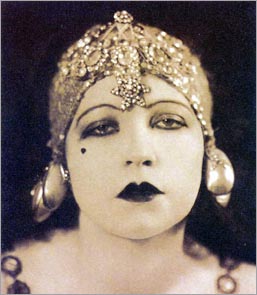

Piroska (Zita)

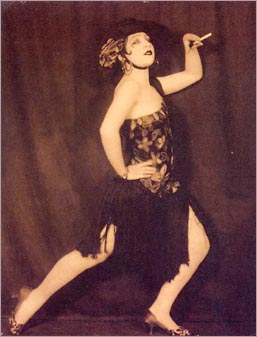

Piroska (Zita)

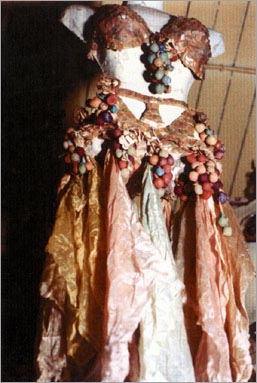

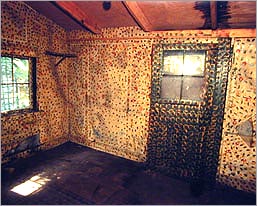

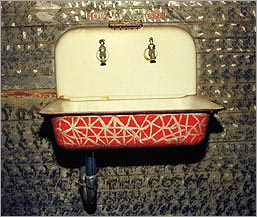

More house photos

|
 |
Finding the real Nita and Zita is
next to impossible. After years of searching through performance
archives and historical collections, and talking to neighbors,
jazz historians and New Orleans historians, there are still
enormous gaps in our knowledge. Here is what we know:
Flora and Piroska immigrated to the U.S. from the Jewish shtetl
of Nagybanya, Hungary, in 1922 to pursue their career as "international
dancers," performing under the names Nita and Zita. Photos
indicate that their act combined burlesque and acrobatics. Together,
they performed all over the United States, and, as far as we
can tell, Shanghai, Panama, and perhaps Paris and Egypt. The
sisters were known for carrying their elaborate, handmade clothes
and costumes with them in two steamer trunks.
In the late 1940's, the sisters settled in New Orleans and became
quite reclusive. Their home became their refuge. They painted
their entire house -- inside and out -- in brightly colored
sponge patterns, and painted most of their furniture with intricate
spider web figures. On the rare occasions that they did leave
the house, they dressed in fine handmade clothes of their own
design.
Flora and Piroska died in 1985 and 1991 respectively. They are
buried in the pauper's section of Hebrew's Rest Cemetery in
New Orleans. The only people present at Piroska's funeral were
a Rabbi and Betty Kirkland, the sisters' next door neighbor.
Upon gaining permission from their only living relative to sell
the sisters' belongings, Ms. Kirkland opened their home to what
became a five-year garage sale. The house was literally packed
with thousands of pieces of handmade clothing, hundreds of photos
of Nita and Zita performing, handmade bead curtains, handmade
placards advertising Nita and Zita performances, and more. Curious
locals, vendors of vintage clothing and -- eventually -- collectors
of outsider art snapped up Nita and Zita's clothes, furniture,
photos and collectibles until Ms. Kirkland closed up shop in
1996. This sparked a veritable New Orleans underground "war,"
as several vintage clothing store vendors and Ms. Kirkland clashed
over who was the authentic protector of Nita and Zita's image
and memory.
Today, Judy's Collage, the vintage store which was the primary
seller of Nita and Zita goods, has closed down. The proprietor,
Cindy MacMurray, has created a website
in Nita and Zita's memory, and made a poster paying homage to
the two sisters. One of Nita and Zita's costumes is in the collection
of the Lousiana State Museum in the French Quarter. We have
a few Nita and Zita pieces which we use in the show, on loan
from a local New Orleans collector. As far as we know, all other
Nita and Zita pieces are scattered across New Orleans and the
country, held by private collectors.
From what we have gathered, Nita and Zita would shop at thrift
stores, looking for clothing made out of the highest quality
fabric possible. They would alter the clothes for fit, as well
as to match their personal style. Many of their dresses featured
long sleeves that tapered down to a point at the knuckles of
the hand. Much of the clothing featured prominent stitching
wit thick, dark yarn. Our costume designer, Olivia Wildz, used
actual Nita and Zita costumes as a starting point and inspiration
for her original designs for the show.
Nita and Zita lived in their house on Dauphine Street in the
Faubourg Marigny from approximately 1947 until their respective
deaths in 1985 and 1991. They were known for making all of the
repairs to their home themselves, including repairs to the roof.
Always resourceful, they fixed the floor of their home with
tin can lids hammered in with tiny nails, and covered over holes
in the wall with fabric. If they were known for their diligent
work ethic, they were NOTORIOUS for their wild aesthetic: they
painted their entire house, inside and out, with wild, abstract
patterns. Bead curtains hung in the archways of their house,
and photos of them in their showgirl prime lined the walls.
In photos of Nita and Zita taken in their home when they were
older, the painted walls and bead curtains give the effect of
a fantastic nightclub or shimmering stage. These
photos were taken by Harold and Holly Gee shortly after
they purchased the house in the early 1990's. The house still
stands, waiting for renovation. Many of the painted walls remain,
though they are now in serious disrepair.
TOP
|
 |


